Navigate This Post
GET OUR FREE WEEKLY NEWSLETTER
Thanks to the combined efforts of Hernando Cortez and Sir Walter Raleigh, hogs have been native to the United States of America for over four hundred years now. Those who make a living selling ham and bacon are grateful for that fact. However, those whose crops and fields are devastated by feral hogs, not so much.
The southern and central US has become the perfect breeding ground for feral pigs with Texas holding the distinctive title of high wild hog population. When I started hunting hogs in the Lone Star State, around 2010, the Texas hog population was pushing 2 million. Today, that number is pushing 3 million with an estimated 6 million plus spread out across various states.
For those wishing to hone their skills in the field with a rifle, Texas is definitely the land of opportunity. Feral hog season is open all year long, day or night.
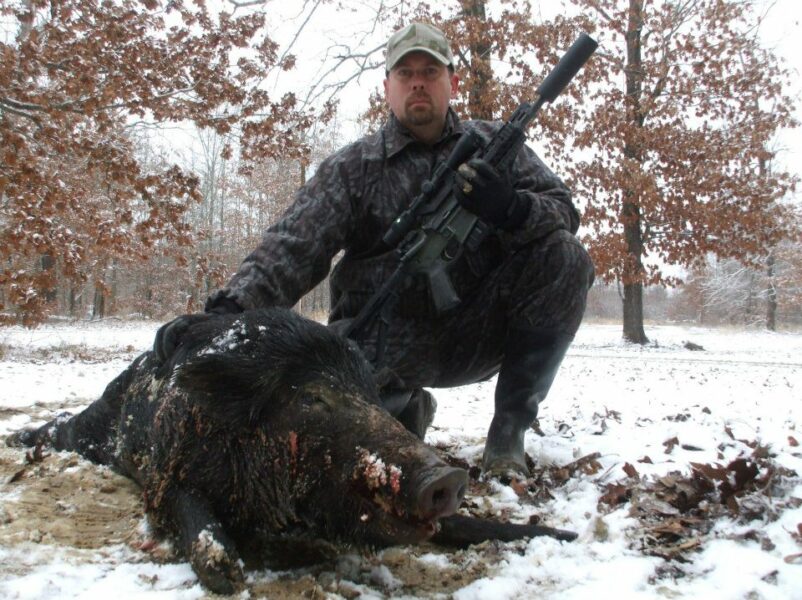
The Author took this big boar in an early February snow in Northeast Texas
Which is the Best Hog Rifle?
I know full well that by posing the question; “which is the best hog rifle?” I am setting myself up for a proverbial donnybrook. Yes, there are men who have killed more hogs than I, nonetheless, I have a fair amount of experience killing them in all weather, during the day and night, from blinds, stalking on foot and in vehicles as well as from the air.
In addition to bolt-action rifles in various calibers and 12 gauge shotguns, I have taken bacon with AR-style rifles chambered in various calibers to include the 6.8mm SPC II, 7.62×40 WT (now .300 HAM’R from Wilson Combat), and .308 Winchester.
I have taken down wild porkers with precision bolt-guns, shotguns, and self-loading rifles fashioned after Gene Stoner’s brainchild. The question recently posed to me was, “If you had to pick one gun, to hunt hogs day or night, in all conditions, which would it be?”
The answer is the AR-15 variant chambered in the 5.56mm cartridge. Go ahead, writhe on the floor and scream about how you cannot kill a hog with a varmint cartridge. I’ll wait.
FREE COURSE
Master the Fundamentals with 7 Training Tips That Could Save Your Life
Sign up now and get started with the course.
A Different Kind of Hunting
Traditional hunters need to pause for a moment and realize that taking out feral hogs, particularly in the Great State of Texas, runs contrary to most any big game hunting sport. While hogs are indeed, “big game”, hunting them is more like a mix of coyote and varmint hunting. With the rare exception of a few folks looking for a wall-mount trophy, when you go to the field to take hogs, you are not thinking “let me find that one perfect boar”.
In order to combat the nearly unchecked spread and billions of dollars worth of crop damage, when we go to the field to hunt hogs, we are trying to kill as many as possible. Hogs also travel in herds or sounders. What this translates to in practical terms is a need for full-capacity rifles that can be put onto multiple, moving targets, in seconds.
Whether you are ambushing hogs from a well-hidden blind, spot stalking them from trucks and ATV’s or running them down from helicopters, you are just as likely to encounter a herd as you are a lone boar. Even if you do spot a big boar off by himself, chances are high that he has friends nearby that you won’t see until the first shot breaks.
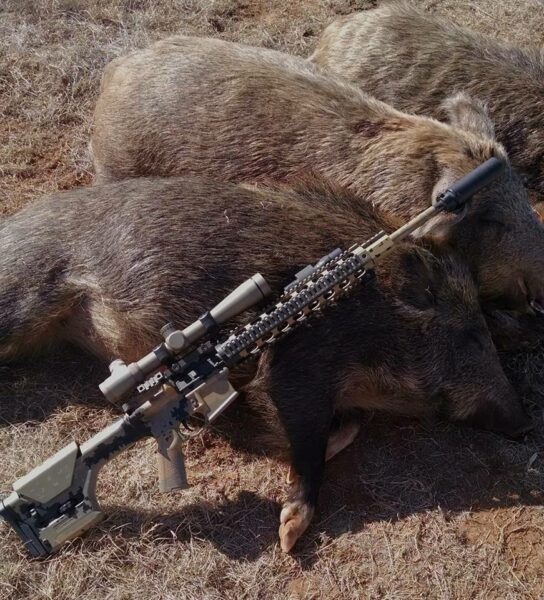
When the circumstances are right, hogs are taken in bunches, not one at a time.
Elusive Game Requires Different Strategy
Those on the outside looking in, the people who read about hog hunting in magazines or who watch TV shows on the subject might assume that because there are millions of hogs in Texas that shooting hogs is easy. Aside from a few fenced-in, pay to play, facilities, hog hunting is NOT easy. If it were easy, their numbers would not be climbing in the hundreds of thousands a year.
Hogs tend to inhabit the most inhospitable areas; swamps, marshes, muddy bottoms, thick brush where rabbits don’t even like to go. As soon as frost goes away and the temperature rises, feral pigs will become almost exclusively nocturnal. During the heat of the day they will lay up on the nasty thickets only venturing out long after sunset to do their dirty business.
Feral pigs will come to feeders in the winter, but only after their supply of free acorns has been exhausted. If they are feasting on some unlucky farmers’ crops, feeders may mean very little to them. Regarding feeders, I have had some days where the hogs swarmed like flies and others where I sat for hours and didn’t see a single animal.
I’m not saying they are impossible to find, obviously that is not true, but they are elusive. There are intelligent animals and their sense of smell rivals that of the best hunting dogs. You must be mindful of the wind direction or they will smell you and be long gone.
With all this being said, we must be able to hunt them day and night. Our options are to have two or three rifles outfitted with long range day scopes / close range day optics and night vision. Or, could we take one rifle and set it up to be used day or night; same gun, rapidly set up for daytime or nighttime, near or far?
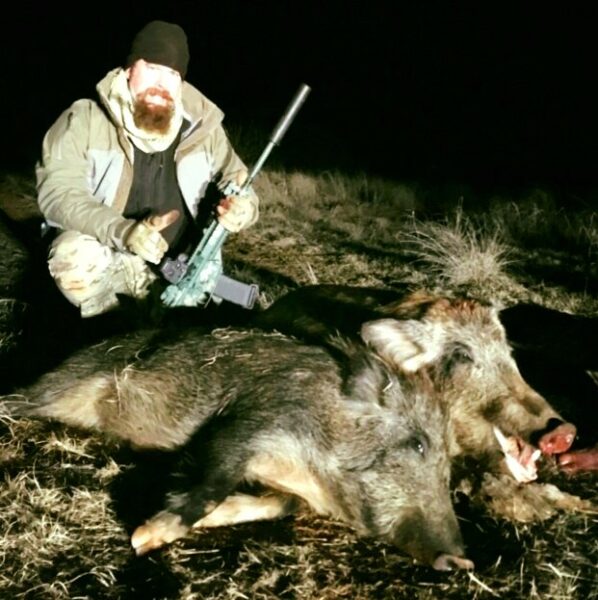
Hogs taken long after dark. Colt LE901 rifle with EOTech HWS.
Colt AR-15
The Colt’s Manufacturing Company has been in financial trouble on and off for a century. However, this fact was never due to them making inferior guns, but instead a product of very poor management. The good news for Colt lovers, if there are any left, is that CZ (CZG-Ceska Zbrojovka Group) purchased them in 2021. Unlike Sam Colt’s old company, CZ apparently understands how to make, market, and sell guns in the 21st century.
For the platform of this project, I chose the Colt LE901 rifle that I have had in hand for ten years or so. Over that decade I have taken this gun to the field and harvested my fair share of game. Colt AR-15 rifles have been the benchmark for quality, if not for availability, for 50 years in the USA. My original review of the gun was published in 2014. The LE901 has the distinction of being a 7.62 NATO rifle built on an AR-15 sized rifle being easily converted to 5.56mm by swapping upper receivers. The 5.56 configuration is my choice here.
DAYTIME
In my decade of taking feral hogs, I cannot recall a time in Texas where a shot beyond 200 to 300 yards or meters would have been practical. I specifically recall stalking a sounder on foot and dropping a boar at right around 200 yards, but that was the exception, not the rule. Most daytime shots were within 100 yards. That being said, adding a high magnification, variable powered scope might be nice, but it is not necessary.
For two decades now, I have had great success with EOTech Holographic Weapon Sights (HWS) and they have never let me down. I installed a model EXPS3 and behind it, a G43 3x magnifier. The EXPS3 uses the famous “dot in a circle” EOTech reticle. The dot is a true 1 MOA and the circle is 65 MOA. This unit also has an “NV” button for night vision capability which will come into play later. The EXPS uses a single CR123 lithium battery.
Depending on your situation you may or may not desire the magnifier. The G43 has a quick-detach lever so it can be removed or added quickly. When not in use at the moment, you simply rotate the magnifier 90º to the right and it is out of the way. Both the optic and magnifier are made in the USA and water-resistant to a depth of 10 meters.
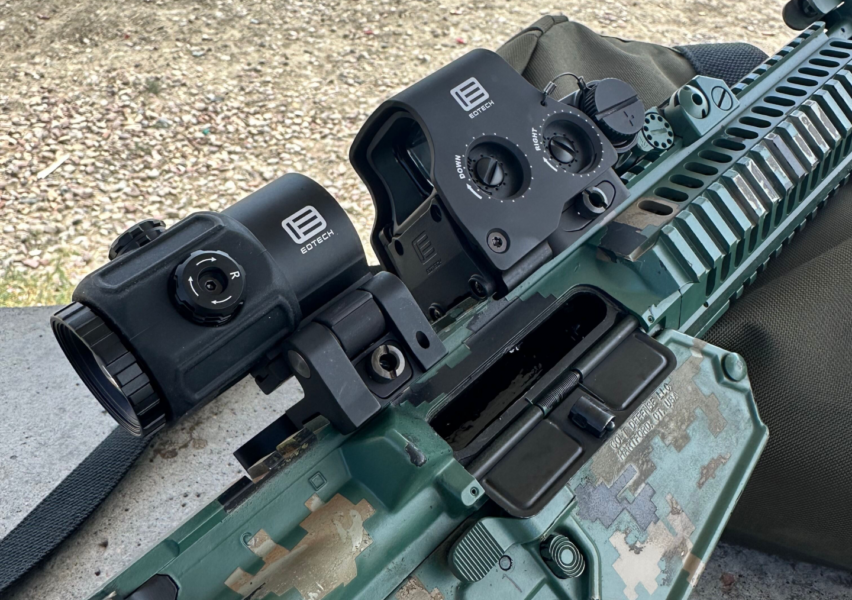
EOTech Day Optic Set Up
NIGHTTIME
Thanks to the rapid advancement in technology during GWoT, both night vision and thermal optics have increased in reliability, decreased in size and become more affordable. By comparison, during the early stages of GWoT, I toured the Insight Technology plant and was allowed to test one of their newest thermal imaging monoculars. The unit price at that time was $25,000. No, that was not a misprint.
Night vision devices in standard (shades of green), white phosphorous (gray tones), and digital (color) have come down in price that the average person can now afford them as opposed to twenty years ago when only agencies spending tax dollars could do so.
Keeping in mind that I wanted to use the same rifle for daytime and nighttime hunting, I purchased a rail mount for my AN PVS-14 Gen II+ monocular. Now, all that is needed to turn the day gun to a night gun is to remove the magnifier and replace it with the PVS-14.
For use in the dark, you simply activate the EOTech optic and depress the “NV” button. Turn on the PVS-14 and boom, Bob’s your uncle, you can now use the EXPS optic in conjunction with the night vision. Remember, all the zeroing is done with the EOTech sight. Adding/removing/swapping the magnifier for the night vision or vice versa does not affect the zero. This is a big deal since you can zero your optic in the daylight as normal and have a zeroed night sight. Try going to the local range after dark and convincing owners to let you BZO your rifle at night.
Magnification for night hunting is not an issue as shots will be taken at relatively close ranges, well within 100 meters. Nocturnal stalking requires that you absolutely must identify your target and that means getting close.
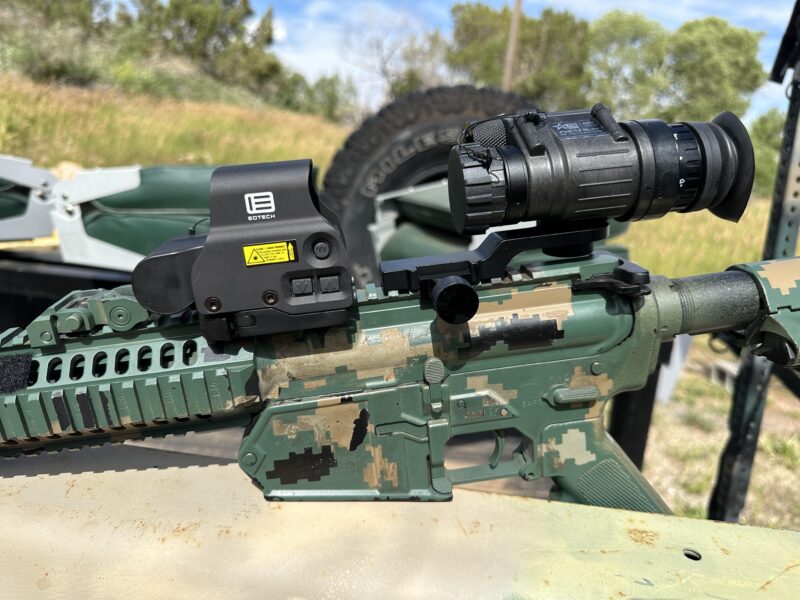
The Nighttime set up with EXPS optic and AN PVS-14 night vision.
IR Lasers
If you want to spend the money and practice a new skill, you can wear the PVS-14 on a head mount and install an IR laser on your rifle. The combination of the IR laser and a suppressor can be particularly deadly to feral hogs who have gone nocturnal.
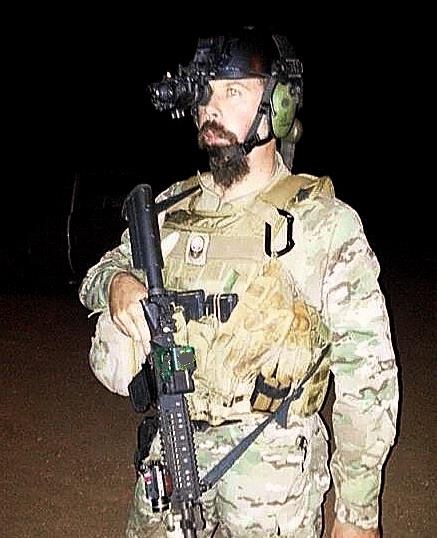
The author with an IR laser set up on Colt LE901 rifle and PVS-14 on a head mount.
Aerial Gunnery
I had the good fortune of going through an Aerial Gunnery Course. That’s fancy terminology for shooting from a helicopter. One of the first things you realize when the bird is moving is that magnified optics are a “No Go”. Even when hovering you are in constant motion.
The EOTech HWS units outperform all others in this regard. Remember, once your EOTech reticle is zeroed, it does not matter where you “perceive” the reticle to be in the housing. As long as you put the dot on the target, you will get a hit (if you press the trigger properly). When firing from the platform of a helicopter, you will be wearing aviation headsets so the pilot can communicate with you. The big ears prevent your traditional cheek weld on the stock. Not to worry, the EOTech HWS gives you a kind of “heads up display”.
Additionally, the “dot in a circle” reticle is tremendously beneficial particularly since it has NSEW tick marks to help not only with “lead” but also with “lag”. The helicopter will be moving faster than the target on the ground. You need to learn to “lag” the target in order to get hits. (That is a whole other topic).
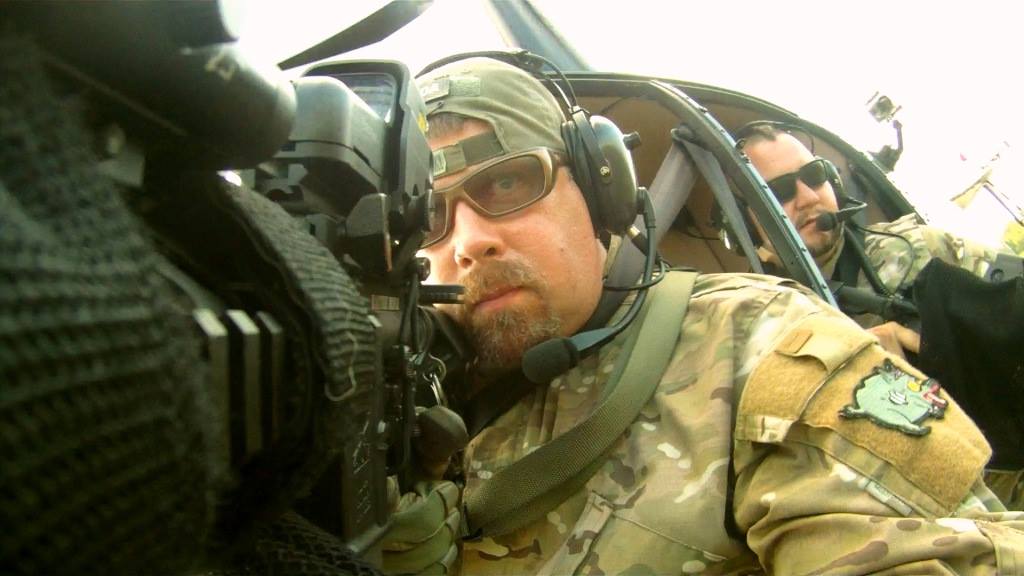
Author engaging from helicopter using rifle equipped with EOTech HWS optic
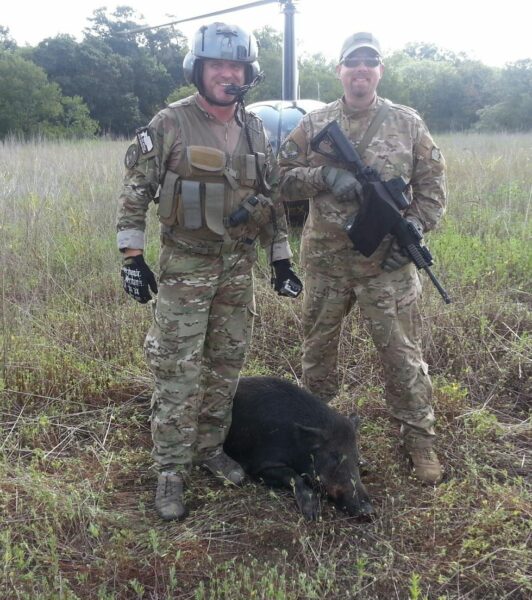
The author and the pilot, Capt. Morgan, after a feral boar and taken down from the air
The 5.56mm Cartridge
Congratulations for getting this far in the review and having the moral courage to read this. The 5.56x45mm NATO cartridge today is not the same as the one fielded during the early days of Vietnam. While there are numerous loads and bullet weights, when it comes to serious use, taking down flesh targets, the Mk262 load is the King of the 5.56.
Using a 77 grain OTM (BTHP) projectile, the Mk262 from Black Hills Ammunition proved to be an extremely effective man stopper for US Army Special Forces in Afghanistan and Iraq. American forces recorded thousands upon thousand of confirmed and EFFECTIVE kills in theater. Snipers operating in urban environments in Iraq often preferred to use tricked out M16 sniper platforms loaded with Mk262. The round suppressed well, was sub-MOA accurate and delivered one shot knock downs. Please give my apologies to your Great Uncle Jim who calls the 5.56 a “gopher round”.
Several years ago I was on a night hunt with three other men in Texas. We surprised a sounder of 20 to 30 hogs and immediately engaged. Our initial count was four or five animals down, the rest scattered into knee high grass. At the time I did not have night vision and was using a suppressed rifle with an EOTech and a Surefire weapon light.
After this initial melee, we walked around and to inspect the damage. After a few minutes, I heard a noise. “Hey, I hear something.” I whispered to my partner. “It’s probably just a killdeer. (bird)” he replied. I raised my rifle and turned on the light just in time to see a big sow heading straight for me. As I had ten thousand times, I flicked off the safety, shouldered the rifle and found the reticle and fired in about a half second.
A single shot of the Mk262 caught her right behind the snout in her shoulder. She dropped about ten yards from me and stayed there. The feral sow weighed approximately 250 pounds. If I was not a believer in the Mk262 before then, I certainly was after that.
The Wrap Up
The moral of the story is simple. First, Texas is the land of opportunity when it comes to honing your stalking and hunting skills, both day and night. Secondly, with an investment in money and time, you can set up a rifle that can be used effectively for both daytime and nighttime hunting.
Professor Paul Markel
Latest posts by Professor Paul Markel (see all)
- Tactical Rifle Tips: Transition Drills - January 5th, 2024
- 40/20/25 Shooting Drill - October 29th, 2023
- Working With Your Body Armor - October 3rd, 2023
- Hi-Point YC9: Yeet Cannon - August 14th, 2023
- Texas Hog Hunting: Day or Night w/ One Rifle - July 25th, 2023






Recent Comments